The Cat’s Eye Nebula is a planetary nebula located approximately 3,300 light-years away in the northern constellation Draco. Its intricate shape and colourful appearance have earned it the nicknames the Cat’s Eye Nebula, the Snail Nebula, and the Sunflower Nebula. The nebula has the designations NGC 6543 in the New General Catalogue and Caldwell 6 (C6) in the Caldwell catalogue of deep sky objects visible in amateur telescopes.
The Cat’s Eye Nebula was one of the first planetary nebulae to be discovered and is one of the most complex planetary nebulae known. It formed around 1,000 years ago, when an aging star reached the end of its life and expelled its outer layers of gas and dust into space. The ejected clouds of material now surround the hot planetary nebula nucleus (PNN), which illuminates them.
Planetary nebulae are relatively short-lived phenomena. They typically last only 10,000 years. The Cat’s Eye Nebula will gradually disperse over the next several thousand years and the progenitor star will eventually cool down and slowly fade away as a white dwarf.
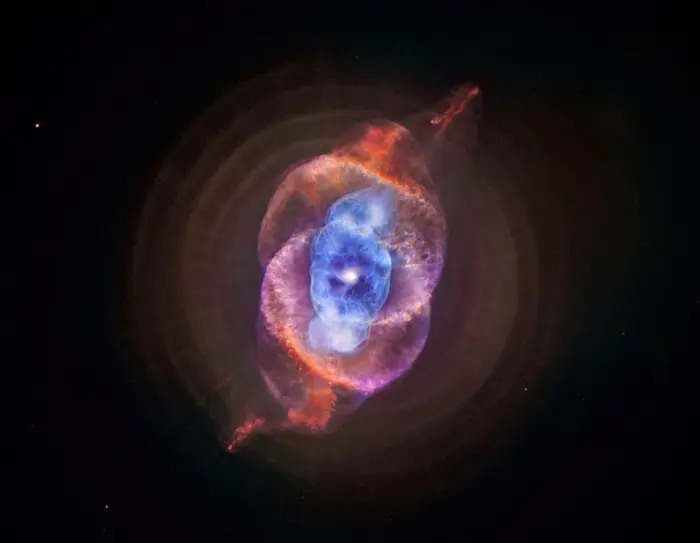
A composite image of data from NASA’s Chandra X-ray Observatory (blue) and Hubble Space Telescope (red and purple) of NGC 6543 shows a phase that Sun-like stars undergo at the end of their lives. Material from the outer layers of the star in the Cat’s Eye is flying away at about 4 million miles per hour. A hot core is left behind that eventually collapses to become a white dwarf star. The Chandra data reveal that the central star in NGC 6543 is surrounded by a cloud of multi-million-degree gas. Image credit: Smithsonian Institution, X-ray: NASA/CXC/SAO, optical: NASA/STScI
The Sun will end its life in similar fashion in about five billion years. It will first expand into a red giant with a diameter about 100 times greater than it originally was and then expel its outer layers into space. The hot central core will emit ultraviolet radiation into the surrounding clouds of gas, causing them to glow.
The Cat’s Eye Nebula is expanding at a speed of 16.4 km/s. Its angular expansion rate is 3.457 milliarcseconds per year.
The nebula is composed mainly of hydrogen and helium, with smaller quantities of heavier elements like carbon, nitrogen, and oxygen.
Observations in the far-infrared band have revealed the presence of cool stellar dust in the nebula. The dust likely formed during the final stages of the central star’s life. It has an estimated mass of 6.4 x 10-4 solar masses and absorbs the light of the PNN. Infrared observations have also detected the presence of un-ionised molecular hydrogen and argon. The bright areas of molecular hydrogen at the inner edge of the nebula’s outer halo indicate the presence of shock waves exciting the molecular hydrogen.
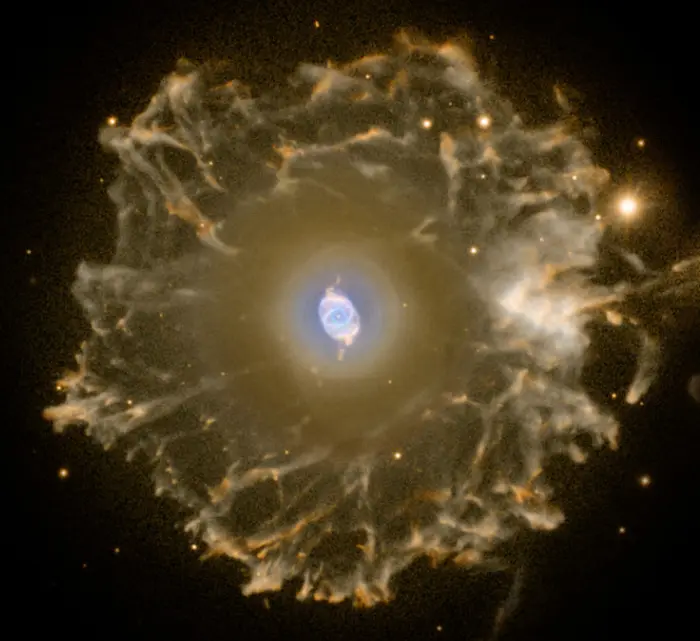
An enormous but extremely faint halo of gaseous material surrounds the Cat’s Eye Nebula and is over three light-years across. Within the past years some planetary nebulae been found to have halos like this one, likely formed of material ejected during earlier active episodes in the star’s evolution – most likely some 50,000 to 90,000 years ago. This image was taken by Romano Corradi with the Nordic Optical Telescope on La Palma in the Canary Islands. The image is constructed from two narrow-band exposures showing oxygen atoms (1800 seconds, in blue) and nitrogen atoms (1800 seconds, in red). Image credit: Nordic Optical Telescope and Romano Corradi (Isaac Newton Group of Telescopes, Spain), ESA/Hubble (CC BY 4.0)
The central progenitor star, catalogued as HD 164963, is an O7 + WR-type star with a radius of only 0.65 solar radii, about 10,000 times more luminous than the Sun. The star has a temperature of about 80,000 K. It is losing around 20 trillion tons of mass per second in a fast stellar wind. This corresponds to a loss of 3.2 × 10−7 solar masses per year.
The star is believed to have originally had a mass of around 5 times that of the Sun and is now estimated to have only over one solar mass. The stellar wind has a velocity of around 1,900 km/s.
The Cat’s Eye Nebula has a complex, intricate structure which includes knots, bubbles, concentric gas shells, and jets of gas. These were revealed in high-resolution images taken with the Wide Field Planetary Camera 2 aboard NASA and ESA’s the Hubble Space Telescope on September 18, 1994. The nebula’s structural complexity may be the result of material being expelled from a double-star system, but the existence of a binary companion has not yet been directly confirmed.
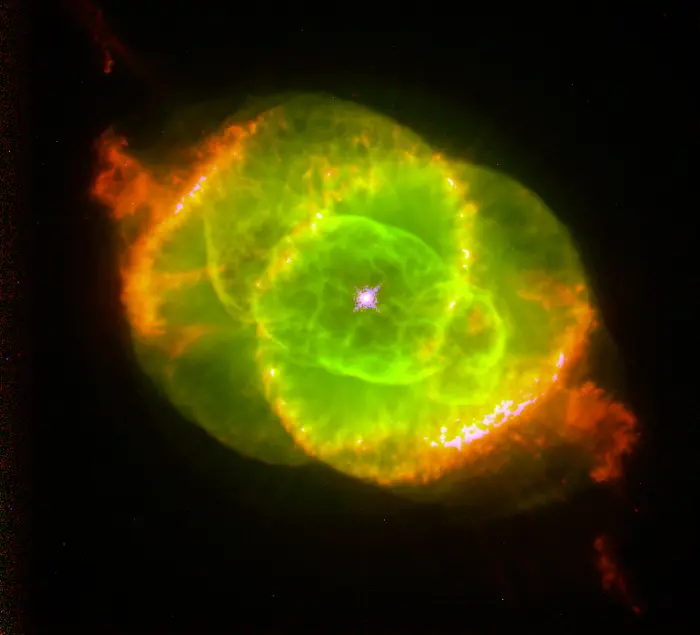
This NASA Hubble Space Telescope image shows one of the most complex planetary nebulae ever seen, NGC 6543, nicknamed the “Cat’s Eye Nebula.” Hubble reveals surprisingly intricate structures including concentric gas shells, jets of high-speed gas and unusual shock-induced knots of gas. Estimated to be 1,000 years old, the nebula is a visual “fossil record” of the dynamics and late evolution of a star. A preliminary interpretation suggests that the star might be a double-star system. The suspected companion star also might be responsible for a pair of high-speed jets of gas that lie at right angles to this equatorial ring. If the companion were pulling in material from a neighboring star, jets escaping along the companion’s rotation axis could be produced. These jets would explain several puzzling features along the periphery of the gas lobes. Like a stream of water hitting a sand pile, the jets compress gas ahead of them, creating the “curlicue” features and bright arcs near the outer edge of the lobes. The twin jets are now pointing in different directions than these features. This suggests the jets are wobbling, or precessing, and turning on and off episodically.
This color picture, taken with the Wide Field Planetary Camera-2, is a composite of three images taken at different wavelengths. (red, hydrogen-alpha; blue, neutral oxygen, 6300 angstroms; green, ionized nitrogen, 6584 angstroms). The image was taken on September 18, 1994. Image credit: NASA J. P. Harrington and K. J. Borkowski (University of Maryland)
The mechanism that produced the nebula’s morphology is not fully understood. The Cat’s Eye contains an inner elongated bubble filled with high-temperature gas. The bubble is embedded within two larger spherical bubbles that are joined at the waist. The waist appears as another large ellipse perpendicular to the one filled with hot gas.
The structure of the bright central region is a result of the fast stellar wind from the central star interacting with the material expelled from the star. The wind has hollowed out the nebula’s inner bubble and burst it at both ends.
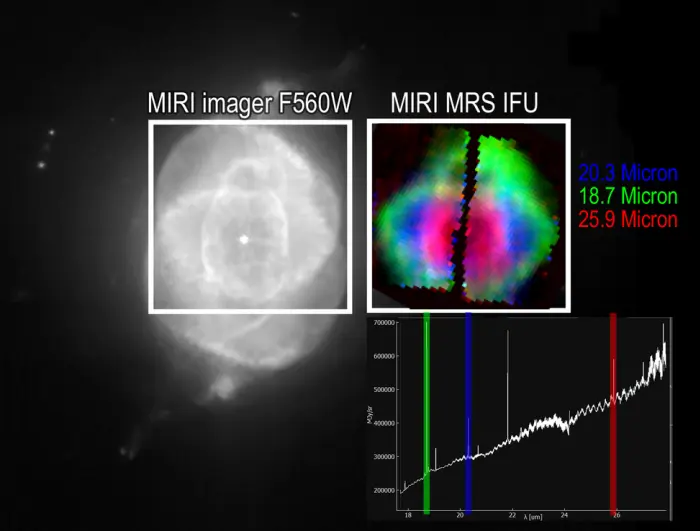
Cat’s Eye Nebula by the James Webb Space Telescope (JWST) – demonstration of MIRI’s imager and medium-resolution spectroscopy (MRS) in IFU mode. Image credit: NASA/ESA/CSA JWST MIRI
The origin of the bull’s eye pattern is still a matter of debate. Some astronomers have proposed cycles of magnetic activity as an explanation, while others have suggested stellar pulsations and the action of a companion star orbiting the progenitor. A companion that is pulling material from a nearby star may also explain the presence of a pair of jets of high-speed gas.
The bright inner portion is surrounded by eleven or more concentric rings. The evenly spaced rings are in fact the edges of spherical bubbles. They are believed to have been ejected when the progenitor star was on the asymptotic giant branch (AGB), before it ejected its outer envelope. The star expelled its material in a series of pulses over 1,500-year intervals. These pulsations produced dust shells, which are arranged in an onion-like structure around the central star. The rings were captured by Hubble’s Advanced Camera for Surveys (ACS) in 2002.
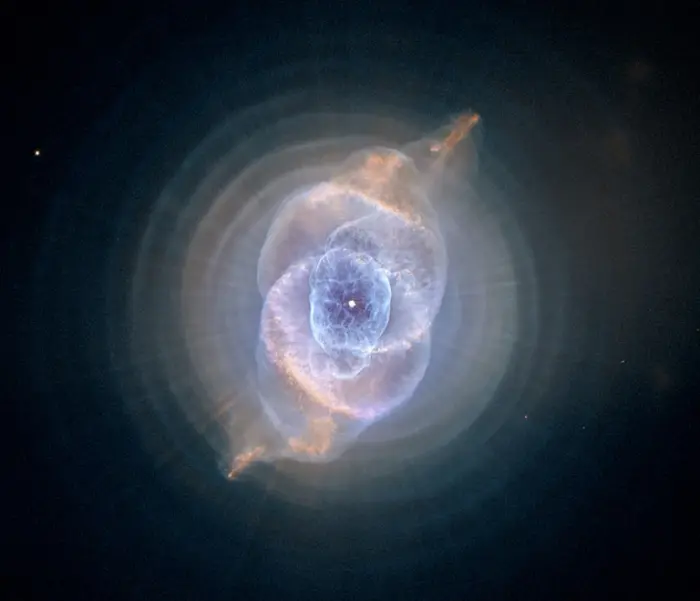
Caldwell 6, also known as NGC 6543 and commonly called the Cat’s Eye Nebula, is as well known as it is enigmatic. Hubble’s stunning image of this remarkable object has garnered fame for both the telescope and the nebula. Caldwell 6 is a planetary nebula — clouds of expanding gas given off by an aging star during its slow end. When a star gets old and its hydrogen fuel runs out, its core collapses and its outer layers puff up. As the collapsing core gets hotter and denser, helium fusion ignites and produces an outward rush of energy that pushes the outer layers of gas into space, forming a nebula. This cycle can repeat, creating a series of gaseous rings around the central star, as Hubble revealed in the Cat’s Eye Nebula. In addition to being one of the first planetary nebulae discovered and the first to be observed spectroscopically, the Cat’s Eye Nebula is (for reasons unknown) also one of the most complex ever observed. This image, captured by Hubble’s Advanced Camera for Surveys in 2002, reveals the nebula’s complexity, including concentric gas shells, jets of high-speed gas, and unusual shock-induced knots of gas. Image credit: NASA, ESA, HEIC and the Hubble Heritage Team (STScI/AURA); acknowledgment: R. Corradi (Isaac Newton Group of Telescopes, Spain) and Z. Tsvetanov – NASA (CC BY 2.0)
The exact mechanism that caused the stellar material to be ejected at the intervals required to form the concentric rings around the Cat’s Eye is not yet known. Pulsations that result in formation of planetary nebulae typically take place at intervals of tens of thousands of years, and smaller surface pulsations occur at intervals ranging from years to decades.
The pulsations that resulted in the creation of the rings are thought to have started some 15,000 years ago and stopped when the central part of the nebula was formed about 1,000 years ago. The nebula’s large extended halo was also created before the main nebula. The halo has a mass between 0.26 and 0.92 solar masses, while the rings have a total mass of around 0.1 solar masses.
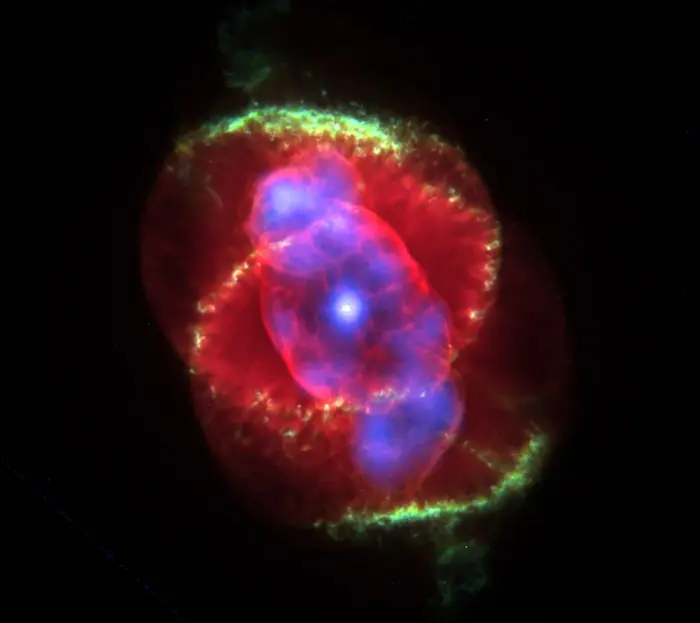
X-ray/optical composite image of NGC 6543, the Cat’s Eye Nebula (X-ray: NASA/UIUC/Y.Chu et al., Optical: NASA/HST). Credit: J.P. Harrington and K.J. Borkowski (University of Maryland), and NASA
The bright inner region of NGC 6543 is relatively small, with the major axis of the inner ellipse spanning only 16.1 seconds of arc. The outer condensations are 24.7 arcseconds across, and the nebula’s extended halo has a diameter of approximately 386 arcseconds, or 5.8 arcminutes.
The outer halo has a temperature of about 15,000 K and consists of the matter that the central star expelled in its red giant stage. It is much less dense than the main nebula. The temperature of the main body of the nebula is between 7,000 and 9,000 K.
Facts
NGC 6543 was discovered by the German-born British astronomer William Herschel on February 15, 1786. Herschel compared the nebula’s appearance to that of the disk of an outer planet when seen through a small telescope, which is how planetary nebulae got their name. Even though the term “planetary nebula” is a misnomer, it has stuck and is still used to denote these objects.
English amateur astronomer William Huggins studied the nebula’s spectrum on August 29, 1864, and showed for the first time that planetary nebulae contain hot gases, but not stars. The Cat’s Eye was the first planetary nebula to be studied with a spectroscope. It has since been observed across the full electromagnetic spectrum, from infrared to X-ray.
Observations at X-ray wavelengths have detected exceptionally hot gas in the nebula, with a temperature of 1.7 x 106 K. The hot gas is believed to be the result of the fast stellar wind interacting with the material previously expelled from the central star. The interaction has produced a hollow bubble in the nebula’s inner region.
Observations with the Chandra X-ray Observatory have also revealed strong X-ray emission from the position of the progenitor star. The emission still intrigues astronomers and may indicate the existence of a hot accretion disk caused by mass transfer in a binary star system.
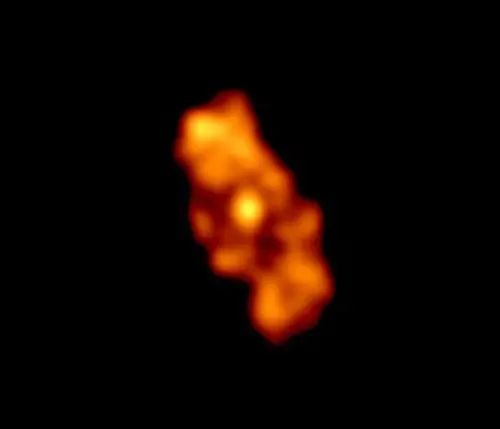
An X-Ray image of NGC 6543 has revealed a bright central star surrounded by a cloud of multimillion-degree gas in the planetary nebula known as the Cat’s Eye Nebula. This image of the Chandra X-Ray Observatory, where the intensity of the X-ray emission is correlated to the brightness of the orange coloring, captures the expulsion of material from a star that is expected to collapse into a white dwarf in a few million years. The intensity of X rays from the central star was unexpected, and it is the first time astronomers have seen such X-ray emission from the central star of a planetary nebula. The ACIS X-ray camera aboard Chandra observed NGC 6543 from May 10-11, 1999 for a total exposure time of 46,000 seconds. Image credit: NASA/UIUC/Y.Chu et al.
The distance of 3,300 light-years is questioned by several sources that suggest that the nebula is 5,300 light-years (1,623 parsecs) away.
The brightest of the knots in the nebula’s halo was discovered by American astronomer Edward Emerson Barnard on April 24, 1900. The knot has its own entry in the IC catalogue: IC 4677. It appears as a portion of a ring around the Cat’s Eye and is separated by 1.8 arcminutes from NGC 6543.

NGC 6543 and IC 4677, image: Wikisky
In 2021, Ryan Clairmont, a high school student and astronomy enthusiast from San Diego, created a 3D version of the nebula and won the “First Award” in Physics & Astronomy for the International Science and Engineering Fair with his submission “Evolution of the Cat’s Eye Nebula revealed through morpho-kinematic and hydrodynamical modelling.”
Clairmont’s 3D model of the Cat’s Eye Nebula was used by Dr. Kimberly Arcand, the Visualization Scientist and Emerging Technology Lead for Chandra, and the Brown University – Chandra XR (extended reality) visualization team, to create a 3D printable VR model of the nebula.
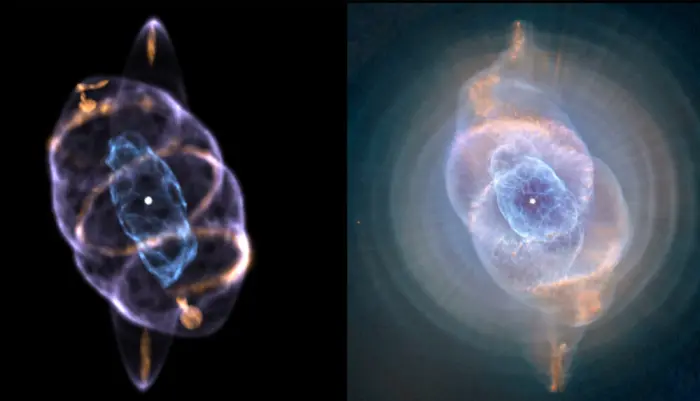
A 3-D model of the Cat’s Eye Nebula (left) reveals partial gas rings (yellow) as well as knots and whorls on either side of the central gas bubble (blue). All of these features were probably sculpted by jets erupting from the nebula’s core. The visualization was created by Wolfgang Steffen of The National Autonomous University of Mexico, Nico Koning from the University of Calgary, and prospective Stanford University student Ryan Clairmont. It is based in part on an image from the Hubble Space Telescope (right). Visualization: R. Clairmont, image: NASA, ESA, HEIC and the Hubble Heritage Team/STSCI/AURA (CC BY-NC-SA 4.0)
In 2022, Clairmont led a study that used the 3D morphokinematic model of the Cat’s Eye Nebula to better understand the nebula’s complex structure. The model was based on a Hubble image of the nebula as well as on spectral data obtained at the San Pedro Martir National Observatory in Mexico. To create the 3D model, Clairmont used SHAPE, 3D astrophysical modelling software developed by Dr. Wolfgang Steffen of The National Autonomous University of Mexico and Nico Koning from the University of Calgary in Canada.
The study revealed point-symmetric partial rings around the nebula’s outer shell. The symmetric rings are believed to have been formed by a precessing jet, a stream of high-density gas expelled from the nebula’s central star in opposite directions. The jet exhibited precession, drawing a circle and producing the rings around the nebula. The presence of the jet provides strong evidence that there is a binary star at the nebula’s core. The study was published in the journal Monthly Notices of the Royal Astronomical Society.
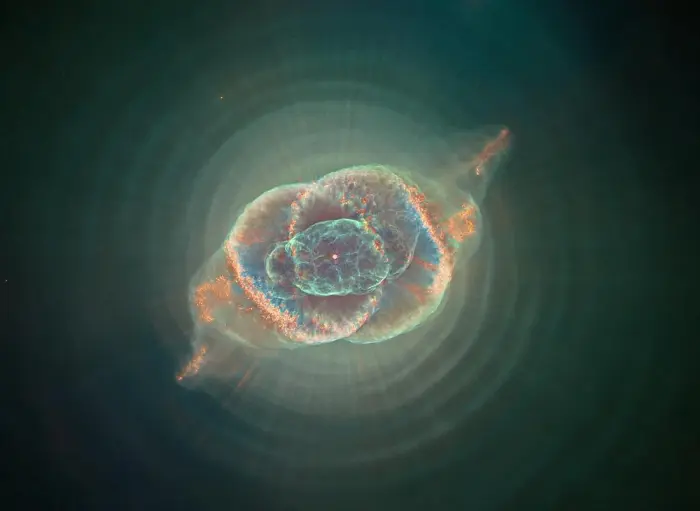
Staring across interstellar space, the alluring Cat’s Eye Nebula lies 3,000 light-years from Earth. The Cat’s Eye (NGC 6543) represents a brief, yet glorious, phase in the life of a Sun-like star. This nebula’s central star may have produced the simple, outer pattern of dusty concentric shells by shrugging off outer layers in a series of regular convulsions. But the formation of the beautiful, more complex inner structures is not well understood. Here, Hubble Space Telescope archival image data have been reprocessed to create another look at the cosmic cat’s eye. Image credit: NASA & ESA (Hubble Space Telescope)
Location
The Cat’s Eye Nebula lies in the constellation Draco, about two fifths of the way from Athebyne (Eta Draconis) to Altais (Delta Draconis). Athebyne is the brightest star along the imaginary line extended from Kochab through Pherkad in the Little Dipper’s bowl, and Altais is the brightest star roughly halfway between Deneb and Kochab.
The Cat’s Eye Nebula is easy to observe from northern latitudes as it is located almost exactly in the direction of the north ecliptic pole. It is 4.4 arcminutes away from the pole.
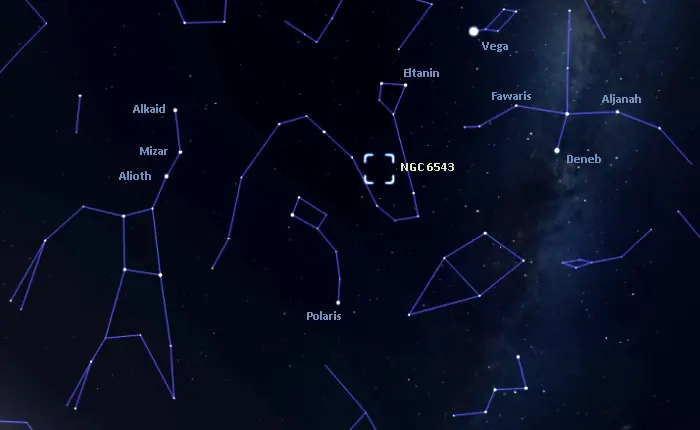
The location of the Cat’s Eye Nebula in Draco, image: Stellarium
In telescopes, the nebula appears as a diffuse blue-green disk crossed by an s-shaped brown curve, with an intricate circular structure at the inner region. The nebula’s core has an apparent size of 20” and a high surface brightness. NGC 6543 has a combined apparent magnitude of 8.1.
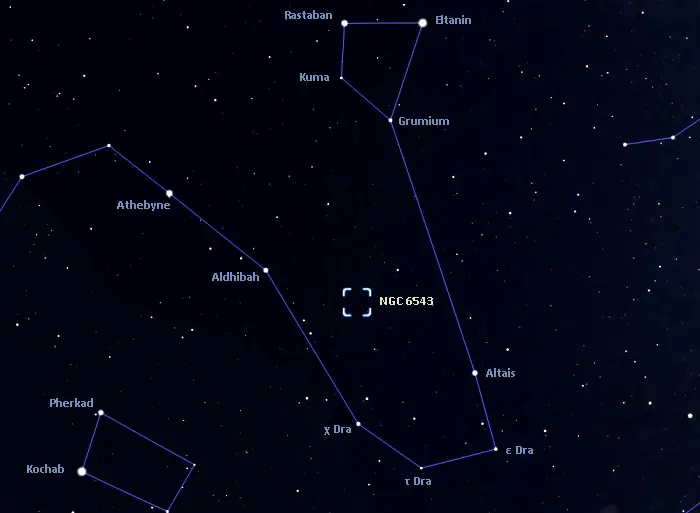
The Cat’s Eye Nebula location, image: Stellarium
For observers in the northern hemisphere, the constellation Draco is visible throughout the year. The best time of the year to see it is during the month of July, when it is prominent in the evening sky. The entire constellation is visible from locations north of the latitude 15° S.
At declination 66° 38’, the Cat’s Eye Nebula never rises for observers south of the latitudes 23° S. It never appears very high above the northern horizon for observers in equatorial latitudes.
Cat’s Eye Nebula – NGC 6543
| Constellation | Draco |
| Right ascension | 17h 58m 33.4039587288s |
| Declination | +66° 37′ 58.750734000″ |
| Apparent magnitude | 9.8B |
| Absolute magnitude | -0.2B (-0.8-0.6) |
| Apparent size (core) | 20 arcseconds |
| Distance | 3.3 ± 0.9 kilolight-years (1.0 ± 0.3 kiloparsecs) |
| Radius (core) | 0.2 light-years |
| Names and designations | Cat’s Eye Nebula, NGC 6543, Sunflower Nebula, Snail Nebula, Caldwell 6, PK 096+29 1, PN VV 143, PN G096.4+29.9, PN VV’ 335, PN ARO 6, ZW VII 759, AG+66 812, BD+66 1066, HD 164963, GCRV 10447, IRAS F17585+6638, IRAS 17584+6638A, 2MASX J17583335+6637591, PLX 4128.00, PPM 20679, NVSS J175833+663758, 2XMM J175833.3+663800, NSV 24075, TYC 4212-508-1, Gaia DR2 1633325248915154176, Gaia DR3 1633325248915154176 |